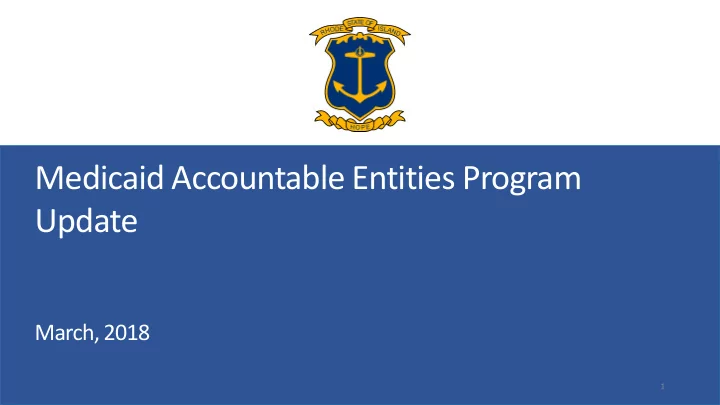

Medicaid Accountable Entities Program Update March, 2018 1
Health System Transformation Program (HSTP) Community University of Rhode Island College of Partnership with Rhode Island College Rhode Island Institutions of Higher Education (DSHP) EOHHS Transitional Health System Program for Health Reinventing Medicaid Transformation Project Hospitals & Workforce Phase II: (HSTP) Nursing Partnerships Accountable Entities Facilities Development of a healthcare One-year transitional System Transformation, including workforce that is aligned with funding to support the the goals of Health System transition to new capacity building toward mature, Transformation and the Accountable Entity broad based AEs and new Governor’s Jobs Plan structures. specialized provider partnerships 2
Medicaid Accountable Entities: Goals ❖ Substantially transition away from fee-for-service models ❖ Define Medicaid-wide population health targets (consistent with SIM), and link any incentive payments to performance ❖ Deliver coordinated, accountable care for all, with targeted support for high-cost/high-need populations ❖ Shift Medicaid expenditures from high-cost institutional settings to community-based settings as appropriate 3
Medicaid Accountable Entities: Approach Program Approach: Three Legged Stool 3. Incentives 2. Payment Targeted Financial incentives 1. Certification to encourage/support for Define expectations for Infrastructure Development Accountable Entities: (HSTP) capacity, structure, processes 2. Payment Require t ransition from fee based to value based payment model (APM Requirements) 4
Medicaid Accountable Entities: Opportunity ✓ Target: high/rising risk population Top 6% of Medicaid users accounting for 65% of cost, especially: Populations receiving institutional and residential services Populations with integrated physical and behavioral health care needs ✓ Alignment of financial incentives (State, MCO, AE) Shared responsibility for reduced cost, increased quality ✓ Transition to risk Using HSTP incentives to encourage/require increased AE financial risk and responsibility 5
Progress to Date The AE Program has grown considerably since inception; first year financial performance is encouraging PMPM AE Savings per Contract AE Pilot Program Attributed Lives* SFY 2017* 160,000 142,947 140,000 $10.18 7 120,000 88,240 $10.12 6 100,000 80,000 5 $5.88 60,000 4 $0.39 40,000 $0.00 3 20,000 0 $0.00 2 Jun-16 Sep-16 Dec-16 Mar-17 Jun-17 Sep-17 $0.00 1 As of Q3 2017 over half (51%) of managed care First year financial performance is encouraging, as 4 of 7 AE enrollment is now attributed to AEs. contracts accomplished shared savings in SFY 17. Source Data: AE Attributed Lives: MCO Quarterly Attributed Lives Snapshot Reports Source Data: MCO Shared Savings Reports 6 Medicaid Managed Care Enrollment: Q3 2017, RI Medicaid Monthly Managed Care Report as of 9/30/17 (Aug, Sept. Average) *Note: UHC Shared Savings results are reported for the period July 2016 – September 2017 *Participating AEs include: Blackstone Valley Community Health Center, CHC ACO, Integra, Prospect CharterCARE, & Providence Community Health Center
Key Challenges Partnership: CMS, State, MCO, AE Flexibility and innovation vs. standardization State budget & administrative resources Sustainability 7
Sustainability Incentive funding provides unique opportunity for startup funds to support investments in critical AE capacity and infrastructure … . ❖ AE Operations Building, maintaining new provider capacity and infrastructure ❖ AE Incentives Interim support for AE Operations ❖ Shared Savings Source of ongoing funding to support AE operations … .Sustainability depends upon AE Savings replacing AE Incentives as source of funding 8
Interagency Alignment goals priorities strategies levers ✓ ALIGNED ✓ MOSTLY ALIGNED ✓ ALIGNED ✓ SOME DIFFERENCES High cost/high need Alternative Payment Set Targets & Metrics (all) Deliver coordinated, accountable care for populations (all) Models (APMs) APMs: Payor vs. all, with targeted Population Differences Enhanced Provider Regulator support for high- Capacity Benefit Differences How to enhance provider cost/high-need Statewide Metrics populations capacity 9
Backup: Targeted Financial Incentives: HSTP Permissible HSTP Expenditures Details of Expenditures ”Attributable to Establishment of AEs” ❖ Incentive based infrastructure funding to AEs ❖ Health Workforce Development ❖ HSTP design, implementation and evaluation ❖ Vital State Health Programs 10
Questions and Comments 11
Recommend
More recommend